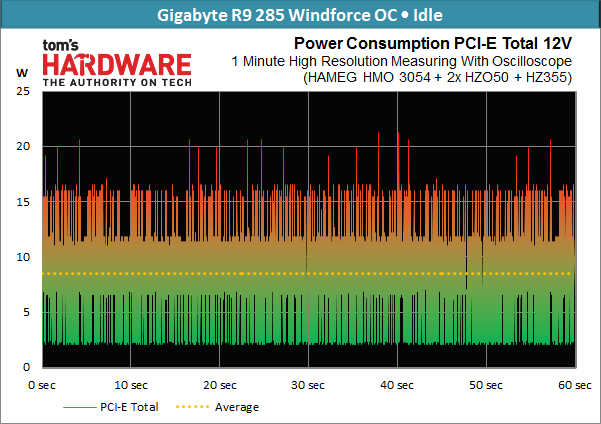AMD Radeon R9 285 Review: Tonga and GCN Update 3.0
On paper, the new Tonga-based R9 285 looks to be slightly slower than the R9 280 it is intended to replace, but there's more than meets the eye.
Why you can trust Tom's Hardware
Idle Power Consumption Results
Power Consumption: Idle (2D Desktop)
Unfortunately, AMD doesn’t fare very well here. We’ve repeated these measurements, reviewed running processes, and even switched systems altogether. We just couldn’t get the Gigabyte Windforce Radeon R9 285 to draw less than 15 W at idle.
Looking at just one minute’s worth of power draw curve after smoothing it over a bit, it’s plain to see that there are significant fluctuations even at almost 0 percent load.
The situation at the motherboard slot looks perfect. We never exceeded or even reached 75 Watts.
Let’s take a look at how that 15 W idle draw is distributed:
| Header Cell - Column 0 | Minimum | Maximum | Average |
|---|---|---|---|
| PCIe 12V | 2 W | 21 W | 8 W |
| Motherboard 3.3V | 1 W | 3 W | 2 W |
| Motherboard 12V | 0 W | 31 W | 5 W |
| Graphics Card Total | 2 W | 45 W | 15 W |
List of All Individual Values per Supply Line
For those readers who like lots of detail, we’ve put together all of the idle power consumption values for each supply line in the gallery below:




Voltages
The voltage values are very important because they’re used to calculate power consumption by multiplying them with the amount of current. Looking at the 12 V rail, we see very clearly that the voltage fluctuates extremely if measured in small increments of time. The average voltage is 12 V, but the switched-mode power supply architecture and the different phases of capacitor load leave a very distinct mark. We’d like to tease our reference article about current graphics cards in relation to common power supply units here, which will cover how the two interact in detail. This is a much more interesting topic than it might appear to be at first glance.
We don’t know yet if the high idle power draw represents a problem in our specific board partner’s card or if it’s a problem inherent in the Tonga architecture. Comparing reviews proves difficult once again in light of the scarcity of actual homogenous reference cards. This is too bad, since we’d have liked the Radeon R9 285 to provide a stronger showing in this arena.
Get Tom's Hardware's best news and in-depth reviews, straight to your inbox.
Current page: Idle Power Consumption Results
Prev Page Watch Dogs and Far Cry 3 Results Next Page Gaming Power Consumption ResultsDon Woligroski was a former senior hardware editor for Tom's Hardware. He has covered a wide range of PC hardware topics, including CPUs, GPUs, system building, and emerging technologies.
-
JeanLuc The idle power consumption numbers are odd, the previous generation cards use less then at idle didn't they? Not that 15 watts is going to break anyone's bank account but its strange nether the less.Reply
Good to see AMD have tackled the noise and temperature issues that have plagued it's previous 28nm cards as well but it's a bit late in the day given that 20nm shouldn't be to far off now. -
gear999 Really nice article guys. I'm impressed by how the 285 actually was able to keep up with the 280. And I'm shocked by the fact that The $250 Nvidia card loses to a $170 AMD card. Thank god I bought a GTX 770 :PReply
Also, on the last page, you guys wrote R7 270X instead of R9, and in the chart it says "Relative to Radeon HD 7950 Boost". Oh, and in the Pros section, it says the 285 has R9 260 like performance?
Thanks for the proofread, fixing it now! :) -
Mike Stewart wow ! at 250$ it actually is a better card even than 280X !! and it was meant for 760....but as it shows here even a 270X is a WAY better card than 760....Reply -
tomfreak Had the tonga 285 come with a 6GHz/7Ghz GDDR5 & 4GB VRAM, the result will be a lot different. Whats with AMD putting on a 5500 memory? facepalm.jpgReply -
srap While this is really a third GCN iteration, showing it as a version number of 3.0 (as in: "Tonga and GCN Update 3.0") makes no sense for me.Reply -
Amdlova some one write this with a .45 acp on the head. I see some error on numbers models etc...Reply
I prefer get a r9 280 and downclock get same results. I can't see the point of this heat on graphics. maybe drivers. OR THIS IS HAWAII XT! Too much Heat! -
Amdlova ReplyI wanted to see the GPU die and OCing results. :(
I think the guys see if they hit the OC the room Will burn! maybe a problem with drivers.
Last time i see that Heat 290x tests. lol! -
Gillerer On the first page, it says "Improvements are always welcome but with the memory interface cut in half compared to the Radeon R9 280,...".Reply
But in fact, the memory interface was cut by a third (384 bit -> 256 bit), not half.
Good point, fixed! Thx.





